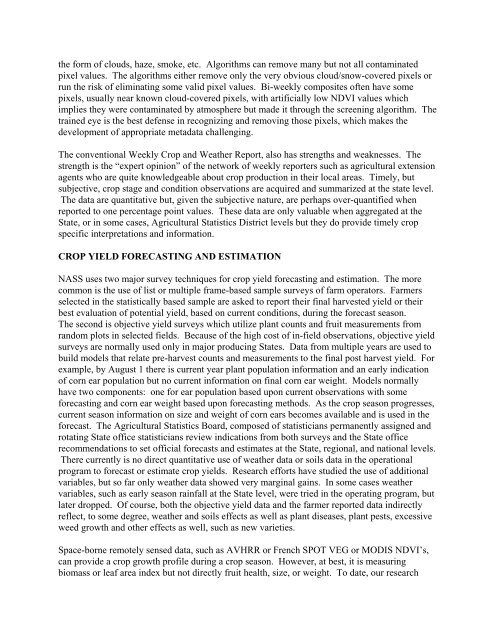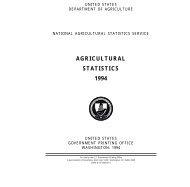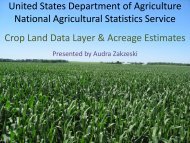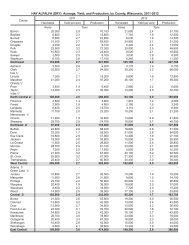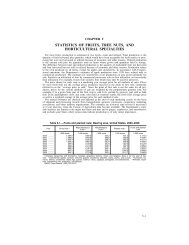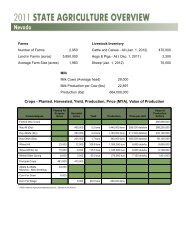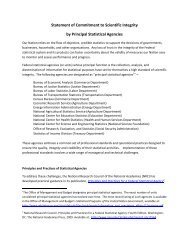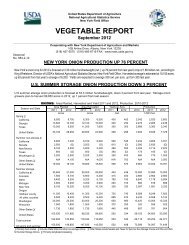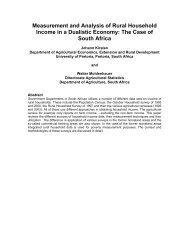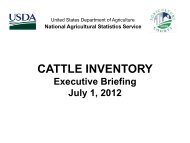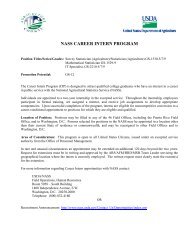LIMITED USE OF REMOTELY SENSED DATA FOR CROP ...
LIMITED USE OF REMOTELY SENSED DATA FOR CROP ...
LIMITED USE OF REMOTELY SENSED DATA FOR CROP ...
Create successful ePaper yourself
Turn your PDF publications into a flip-book with our unique Google optimized e-Paper software.
the form of clouds, haze, smoke, etc. Algorithms can remove many but not all contaminatedpixel values. The algorithms either remove only the very obvious cloud/snow-covered pixels orrun the risk of eliminating some valid pixel values. Bi-weekly composites often have somepixels, usually near known cloud-covered pixels, with artificially low NDVI values whichimplies they were contaminated by atmosphere but made it through the screening algorithm. Thetrained eye is the best defense in recognizing and removing those pixels, which makes thedevelopment of appropriate metadata challenging.The conventional Weekly Crop and Weather Report, also has strengths and weaknesses. Thestrength is the “expert opinion” of the network of weekly reporters such as agricultural extensionagents who are quite knowledgeable about crop production in their local areas. Timely, butsubjective, crop stage and condition observations are acquired and summarized at the state level.The data are quantitative but, given the subjective nature, are perhaps over-quantified whenreported to one percentage point values. These data are only valuable when aggregated at theState, or in some cases, Agricultural Statistics District levels but they do provide timely cropspecific interpretations and information.<strong>CROP</strong> YIELD <strong>FOR</strong>ECASTING AND ESTIMATIONNASS uses two major survey techniques for crop yield forecasting and estimation. The morecommon is the use of list or multiple frame-based sample surveys of farm operators. Farmersselected in the statistically based sample are asked to report their final harvested yield or theirbest evaluation of potential yield, based on current conditions, during the forecast season.The second is objective yield surveys which utilize plant counts and fruit measurements fromrandom plots in selected fields. Because of the high cost of in-field observations, objective yieldsurveys are normally used only in major producing States. Data from multiple years are used tobuild models that relate pre-harvest counts and measurements to the final post harvest yield. Forexample, by August 1 there is current year plant population information and an early indicationof corn ear population but no current information on final corn ear weight. Models normallyhave two components: one for ear population based upon current observations with someforecasting and corn ear weight based upon forecasting methods. As the crop season progresses,current season information on size and weight of corn ears becomes available and is used in theforecast. The Agricultural Statistics Board, composed of statisticians permanently assigned androtating State office statisticians review indications from both surveys and the State officerecommendations to set official forecasts and estimates at the State, regional, and national levels.There currently is no direct quantitative use of weather data or soils data in the operationalprogram to forecast or estimate crop yields. Research efforts have studied the use of additionalvariables, but so far only weather data showed very marginal gains. In some cases weathervariables, such as early season rainfall at the State level, were tried in the operating program, butlater dropped. Of course, both the objective yield data and the farmer reported data indirectlyreflect, to some degree, weather and soils effects as well as plant diseases, plant pests, excessiveweed growth and other effects as well, such as new varieties.Space-borne remotely sensed data, such as AVHRR or French SPOT VEG or MODIS NDVI’s,can provide a crop growth profile during a crop season. However, at best, it is measuringbiomass or leaf area index but not directly fruit health, size, or weight. To date, our research


